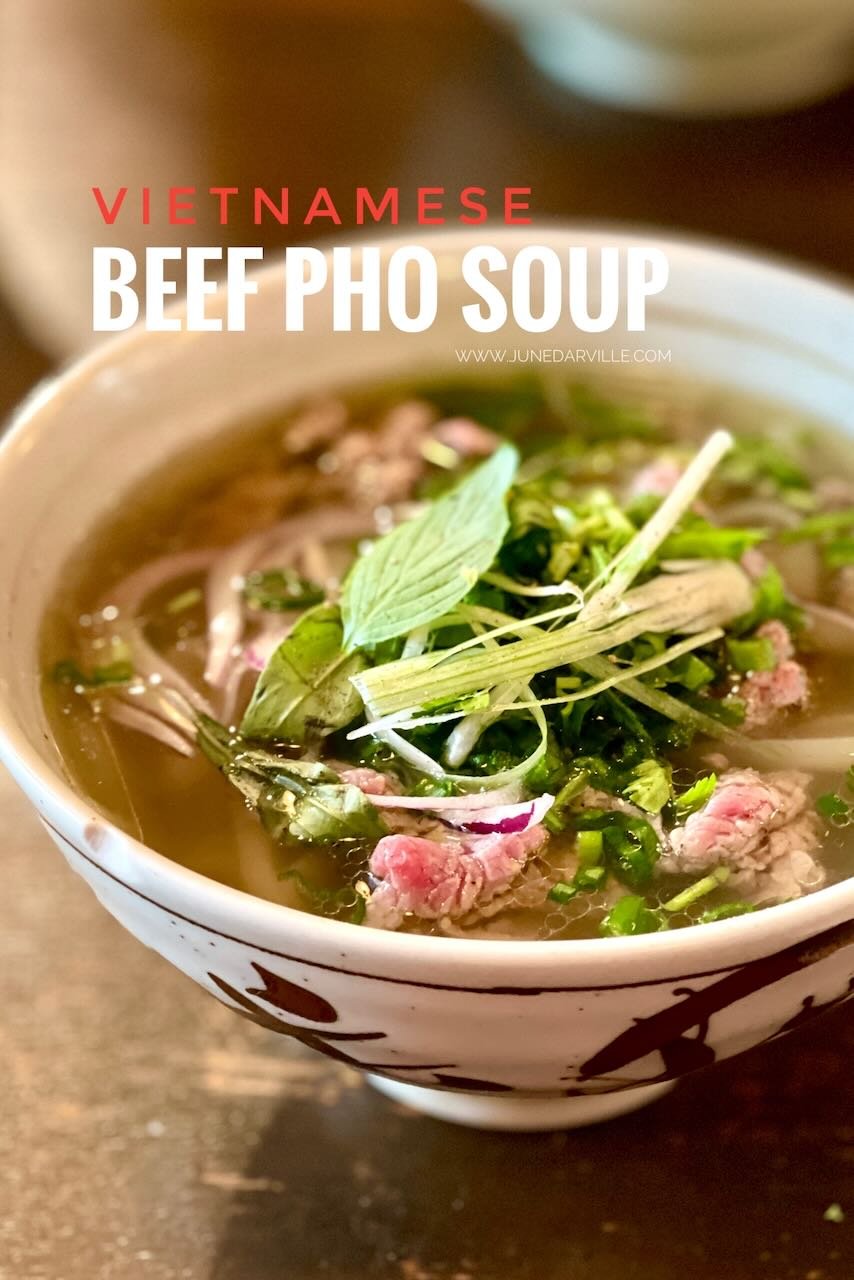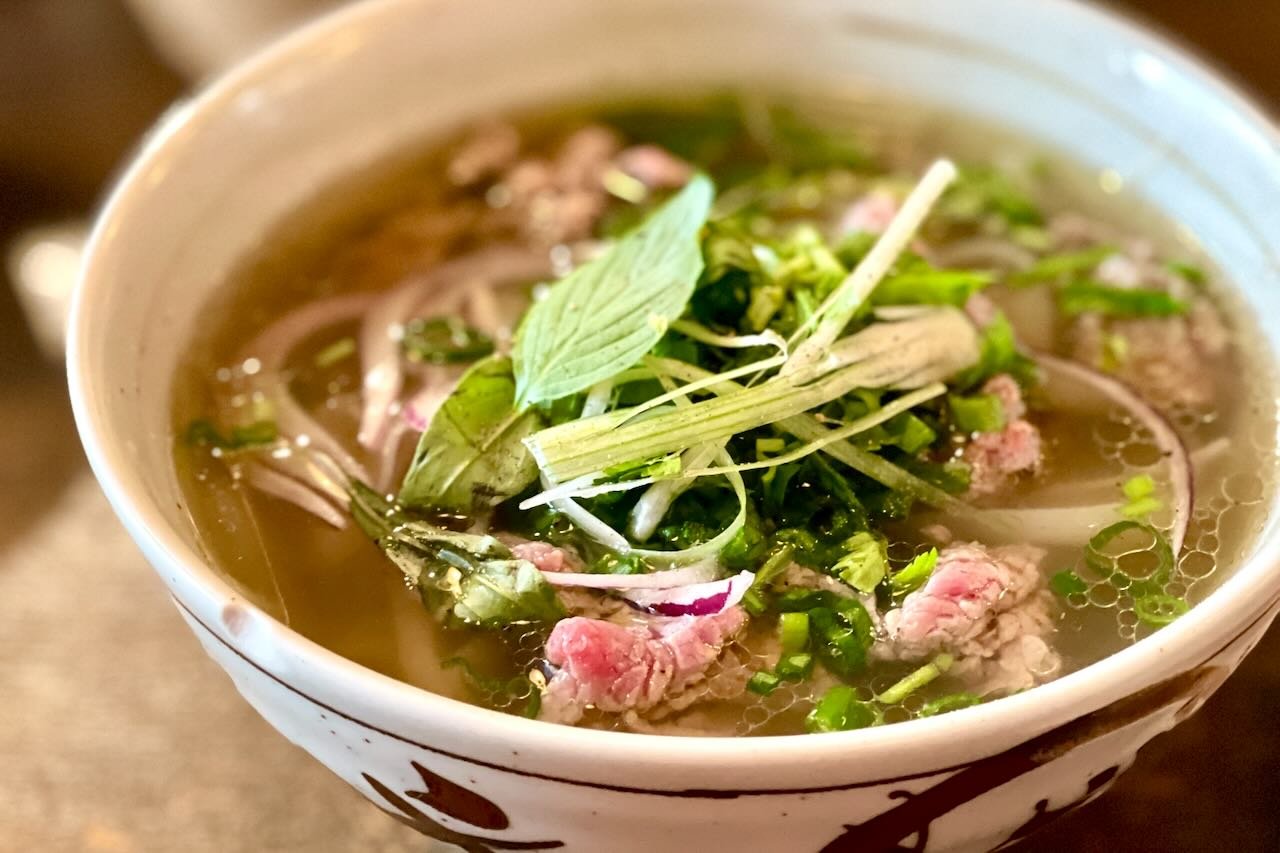 Few dishes achieve the harmonious depth and comfort of a well-made bowl of Vietnamese beef pho soup. And for good reason!
Few dishes achieve the harmonious depth and comfort of a well-made bowl of Vietnamese beef pho soup. And for good reason!
Universally loved for its aromatic broth and rice noodles, pho is more than a meal—it is a cultural icon with a story simmering as richly as its spices.
Together with bo la lot, this pho soup is definitely in our top 3 of favorite Vietnamese dishes!
In this post, let’s explore the history and origin of pho, its variations, and share my very own tried-and-true pho soup recipe for you to make at home!
Whether you are new to Vietnamese cuisine or looking to recreate an authentic bowl, this guide will give you everything you need to ladle up flavor.
Let’s get this thing going!
A Brief History of Pho Soup
Pho (pronounced “fuh”) is a Vietnamese noodle soup that first emerged in northern Vietnam in the early 20th century, likely in Nam Định province. The dish was influenced by French colonists who introduced beef eating to the Vietnamese.
Before that, cows were mainly used for labor and rarely consumed.
As beef gained popularity, local vendors created soups using leftover bones, slowly simmered to draw out flavor. These early bowls of pho soup combined beef broth, rice noodles (bánh phở), and scallions or herbs. French pot-au-feu and Chinese noodle soups may have also inspired its development.
After the 1954 partition of Vietnam, pho migrated south with refugees, adapting to local tastes. Southern-style pho introduced sweeter broth, more herbs, and a variety of condiments—like hoisin and sriracha.
Today, pho soup exists in many forms, but its essence remains unchanged: a soulful, comforting bowl that brings people together.

What Makes Beef Pho So Special?
A classic bowl of beef pho soup (pho bo) contains:
- Clear beef broth flavored with charred onion, ginger, and warm spices (star anise, cinnamon, cloves)
- Thin slices of beef—typically brisket, flank, or eye of round
- Rice noodles (flat, white bánh phở noodles)
- Fresh herbs like Thai basil, cilantro, scallions, and mint
- Optional toppings: bean sprouts, lime wedges, sliced chilies, hoisin sauce, and fish sauce
The magic lies in the broth, simmered for hours to extract marrow, collagen, and spice essence. Done right, it is both light and incredibly rich—fragrant without being overpowering.
Easy Vietnamese Beef Pho Soup Recipe
Ready to bring pho soup into your own kitchen?
Here’s a simplified, yet authentic flavored, pho soup recipe that doesn’t require rare ingredients or a full day—but still delivers fantastic flavor.
A family favorite here!
Ingredients for 4
- 3.3 lbs (1.5 kg) beef bones (preferably marrow and knuckle bones)
- 10,5 oz (300 g) beef brisket or flank steak
- 1 onion (halved)
- 1 thumb-sized piece of ginger (halved lengthwise)
- 1 cinnamon stick
- 2 star anise
- 3 cloves
- 1 tsp organic coriander seeds
- 2 tbsp fish sauce
- 1 tbsp sugar
- salt to taste
- 6,5 cups (3 l) water
- 1 lb (450 g) dried rice noodles (pho noodles)
- 5,5 oz (155 g) raw beef sirloin or eye of round (thinly sliced)
Toppings to taste: bean sprouts, Thai basil, cilantro, mint, lime wedges, fresh red chili slices, hoisin sauce, sriracha sauce
Instructions
1. Char the aromatics
Place the onion and ginger (cut side down) directly onto a dry skillet or under a broiler until blackened (about 5 minutes). This will add depth to the pho soup broth.
2. Prepare the broth
In a large pot, add the beef bones and brisket. Cover with water and bring to a boil. Boil 5 minutes, then discard the water and rinse the bones. This removes impurities for a clearer broth.
Refill the pot with 6,5 cups (3 l) of water. Add the bones, brisket, charred onion, ginger and all the spices. Simmer uncovered for 3 hours, skimming occasionally.
3. Season the broth
After 3 hours, remove the brisket (set aside to slice later). Add fish sauce, sugar and salt to taste. Strain the broth through a sieve into a clean pot.
4. Cook the rice noodles
Soak the dried rice noodles in hot water for about 30 to 40 minutes or boil them until tender (see package instructions). Drain and rinse.
5. Assemble the bowls
Place the rice noodles in serving bowls. Add slices of the cooked brisket and the raw sirloin (the raw beef will cook in the hot broth). Pour the steaming hot pho soup broth over the meat and noodles.
6. Garnish and serve
Top with fresh herbs, lime, bean sprouts, and chilies. Offer hoisin and sriracha on the side.

Tips for Maximum Flavor
– Use marrow bones for rich broth and natural umami
– Char aromatics well—blackened onion and ginger are key
– For deeper flavor, toast spices briefly before adding to broth
– Freeze thin slices of raw beef for 15 minutes before cutting—it’s easier to get paper-thin slices
Pho Soup Variations to Explore
– Pho Ga: Chicken pho with lighter broth
– Pho Chay: Vegetarian pho with mushrooms and veggie stock
– Pho Tái: Rare beef pho (beef added raw into hot pho soup broth to cook instantly)
– Pho Sate: Spicy pho with lemongrass and chili oil
Each version offers a twist, but the core experience—a warm, fragrant bowl brimming with noodles and comfort—is consistent.
Cultural Significance
Pho soup isn’t just a dish—it’s a daily ritual for many in Vietnam. Street vendors start simmering pots as early as dawn, offering bowls to workers and families before sunrise. Internationally, pho has become a symbol of Vietnamese identity, often served at festivals, weddings, and cultural gatherings.
If you ever visit Hanoi or Ho Chi Minh City, expect passionate debates over which region serves the “true” pho. But for most food lovers, every bowl is valid—and every slurp is a celebration of heritage.
Conclusion
Pho soup is proof that comfort food doesn’t have to be complicated—just built with care, flavor, and tradition. Whether you are longing for an authentic taste of Vietnam or simply want a hearty soup to soothe your soul, this pho recipe is your starting point.
Now that you know the origins and secrets behind this iconic dish, why not try making it yourself? Tag your bowl, share your toppings, and most importantly—enjoy every spoonful.